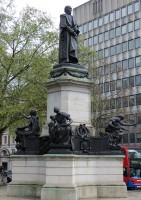
The Gladstone Memorial is one of the more significant memorials in London. If we consider a hierarchy of monuments, with the average being a single figure of a personage on a tall pedestal, then to have four allegorical groups around the central statue is a fairly ennobled place. In London, after the Albert Memorial, unrivalled in Britain, the Victoria Memorial in front of Buckingham Palace, the mighty single figure of Achilles for Wellington (see the Hyde Park Corner page), and the two great pillars to Nelson (with his lions) in Trafalgar Square and the Duke of York in Waterloo Place, the next size down is the Gladstone memorial – indeed there are not so many others in London with several groups – the Wellington monument at Hyde Park Corner has four standing figures around the equestrian figure, and Queen Anne in front of St Pauls has four allegorical figures, and comparable in weight would be Boadicea at Westminster Bridge in her mighty chariot, but not much else.
The sculptor of the Gladstone Memorial was Hamo Thornycroft, an important sculptor, his works spanning late Victorian and Edwardian times, and through past WW1. Among his various public statues are the gargantuan King Alfred in Winchester, and in London Cromwell outside the Houses of Parliament (see this page) and General Gordon on the Embankment.
Gladstone is one of the most recognisable British statemen, with his high, rounded forehead exposed by swept-back hair, stern, mobile face, and snub chin, and generally pictured as a fairly elderly figure. Here, he stands erect, enveloped in a highly decorated robe so that we see little of his pose or figure: just his skeletal clasped hands, and his shoes underneath his cloak. The effect is to maximise the solidity and give stature to a rather slightly built man. Even with this, there is a gauntness or spareness to the figure, especially when viewed from the right hand side in profile.
The treatment of the drapes is subtle – as well as the variety of patterning, the material itself is shown slightly crinkly, in contrast to the broad sweep of the main folds over the arms, shoulder and lower body.
Brotherhood, Education, Inspiration and Courage.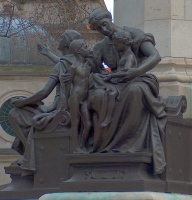
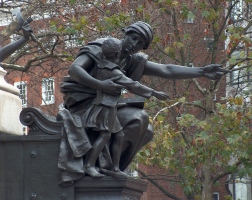
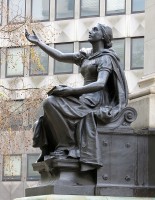
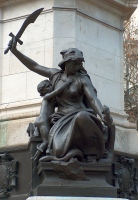
The four allegorical figures around the base of the monument are something special. They represent Brotherhood and Education in the front, as we face the monument, and Inspiration and Courage at the back – the latter being one of the iconic statues of Edwardian allegory.
Brotherhood shows a young mother with two boys, the one a standing nude youth of perhaps six or seven years old, his mother’s arm protectively around his back and upper arm, and the other, rather younger, seated on his mother’s lap. Both have the gawky pose and thinness to arms and legs which comes as infant plumpness is replaced by fast-growing bones outpacing muscle and flesh. By contrast to these, the mother is all gracefulness and mature femininity, expressed in the gentle curve of arms and neck, and emphasised in the elegant line of the drapes covering her legs.
Education has the female allegorical figure with one arm outstretched, perhaps pointing to some distant land referred to in the book on her lap, the other around the schoolboy standing next to her, looking into her face ot catch her every word. A very three-dimensional group, showing a harmony of composition from different aspects, in particular from the left hand side, as shown here.
Inspiration has no accompanying child, but consists of a single female figure, gazing upwards, one hand raised, the other on a book presumably the Bible. For this is a religious inspiration, emphasised by her posture, almost crouched rather than seated, as if in an attitude of prayer. The upward look is so familiar from Victorian religious pictures that this figure has somewhat of an air of conventionality about it, yet it too is most fine, with her robe, held at the base of the throat by a single broach with a cross on it, swept back over her shoulders, and her heavy skirt giving fine lines to the lower figure.
Finally, Courage, a dramatic group of a mother defending her child from danger. The child, naked and vulnerable, clutches in alarm at the body of the mother, who has seized the neck of the marauding snake in one clenched fist, the other powerful hand holding the short curved sword with which she is about to strike off its head. She wears on her head a Heraclean lion’s head and skin, symbol of strength (more examples of this at the bottom of this page), and though seated, like the other figures, the sense of dramatic movement is shown in the force of her arm, the twist of the drapery across her stomach, and the push of her knee to crush down on the body of the snake. A splendid creation.
We may comment on the style of Thornycroft’s female figures – they are Amazonian Greek, full-figured and feminine, but muscular in upper arm and shoulder, and with faces hard and chiselled, rather than soft and kindly. They should be compared with the similarly heroic females of Thomas Brock’s Victoria Memorial. This is not to say that Thornycroft never made more slender, girlish figures – his late nude entitled The Sandal comes to mind – but most of his figures are more like the Gladstone ones.
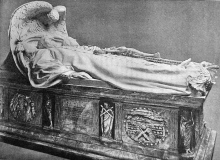 Gladstone Monument, Hawarden, Wales, by W. B. Richmond.
Gladstone Monument, Hawarden, Wales, by W. B. Richmond.
Gladstone has many monuments across the country, and we may note some of the other well-known ones as being:
Among many busts of Gladstone, I will mention only the particularly noble youthful bust by Thomas Woolner, in the Ashmolean Museum in Oxford, of marble and with scenes from the Iliad on the base.
The Gladstone Memorial stands part way along the Strand, subject of a sculpture walk on these pages, and facing the sculpture on Australia House, also subject of a separate page.
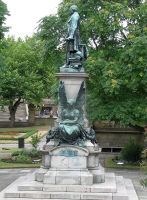
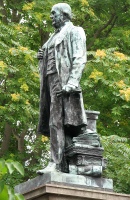 Liverpool Gladstone statue by Thomas Brock.
Liverpool Gladstone statue by Thomas Brock.
This page was originally part of a 'sculpture of the month' series, for Mar.2013. Although the older pages in that series have been absorbed within the site, if you would wish to follow the original monthly series, then jump to the next month (Apr.2013) or the previous month (Feb.2013). To continue, go to the bottom of each page where a paragraph like this one allows you to continue to follow the monthly links.
Sculptors // London sculpture // Allegorical statues
Visits to this page from 13 Mar 2014: 12,863